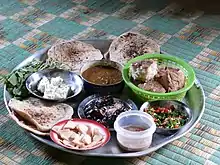Eish shamsi
Eish shamsi (Egyptian Arabic: عيش شمسي), is a thick sourdough bread eaten in Egypt made with wheat flour.[1] In Upper Egypt it replaces eish baladi as the local staple,[2] although the latter is common as well. The name, which translates to "sun bread", is thought to derive from the practice of letting the dough rise in the sun.[2] The bread is traditionally baked at home in domed clay ovens with openings at the top, although this tradition is fading with pre-made bread becoming increasingly common.[1]
 A rural breakfast accompanied by eish baladi and eish shamsi | |
| Type | Sourdough |
|---|---|
| Place of origin | Egypt |
| Region or state | Upper Egypt |
Shape
The shape of the bread is determined by the pattern of the scoring, which is done with a needle.[1] The common way to do it is making slits all around the top-edge for a round bread.[1] Another common way to do it is making crescent-shaped slits in the dough which results in a triangle-shaped bread.[1] Christians tend to score the dough in a way that achieves a rough cross-shape.[1] These bread shapes resemble those on depictions of bread offerings on tomb paintings dating back to ancient Egypt.[1] Although it is uncommon in Lower Egypt, some bakeries in Cairo make it especially for their Upper Egyptian clientele.[2]
See also
References
- Weintz, Aurelia. "Shamsi Bread". Slow Food. Slow Food Foundation for Biodiversity. Retrieved 11 March 2018.
- El-Behary, Hend (2015). "Al-Shamsi "an ancient" bread still baked in upper Egypt". Egypt Independent. Retrieved 11 March 2018.